
Articles
Behavior
Breeding
Characteristics
Conservation
Curiosities
Diet
Facts
Photo Gallery
Types of Penguins
Emperor Penguins Characteristics
Emperor Penguin:
Family: Spheniscidae
Class: Aves
Subphylum: Vertebra
Order: Sphenisciformes
Phylum: Chordata
Kingdom: Animalia
Latin Name: Aptenodytes forsteri
- Weight : 20 to 45kg
- Height: 120 cm.
- Habitat : Antarctica Continent
- Food : Squids, small fish and crustaceans
- Reproduction age: 5 years old
- Swimming: Dive more than 300 meters, usually only goes 50 meters deep, can stay 8 minutes below water.
- Population: Around 200 thousand pairs.
- Color: Black and white
- Can live: 30 to 35 years
Size
It is the largest of all the species of penguins and can reach more than 1.20 meters in height and weigh more than 40 kg.
Appearance
Its pelage is bluish gray on the back, white on the abdomen and black on the head and fins. The adult is characterized by having large orange or yellow spots on the sides of the neck. They are well and fatty (have a thick layer of fat), which helps them withstand the cold. His feet have strong claws to grab the ice while riding.
The emperor penguin(Aptenodytes forsteri) is the largest bird of the family Spheniscidae (penguins). The adult can measure up to 1.1 meters in height and weigh up to 30 kg. The males of this species are one of the few animals that spend the winter in Antarctica.
His diet is based on small fish, squid and krill, fish in depths of up to 250 meters. The emperor penguin-can stay submerged for about twenty minutes without breathing. The natural predators of this species include Killer whales, sharks, leopard seals, Antarctica giant petrels and skua.
The reproductive pattern method is fairly typical. The females lay a single egg in May / June, the end of the autumn, leaving immediately to spend the winter at sea. The egg is incubated by the male for about 65 days, which correspond to the Antarctic winter. To overcome temperatures of -40 º C and winds of 200 km / h, males agglomerate and spend most of the time sleeping to save energy. They never leave the egg, it would die of cold. The males survive on the layer of fat accumulated during the summer. The female replaces the male only in early spring. If the Penguin chicks hatch from the egg before the return of the mother, the male of the emperor penguin-feeds the child with secretions from a gland in their existing special esophagus

• Scientific name: Aptenodytes forsteri
• This species is the largest of the family Penguins
• Pelage: The pelage of this species is its biggest difference from the other Penguins, as multicolor: gray-blue on the back, white and black in the abdomen in the head and fins and with an orange band around the ears.
The origin of the name “penguin” is obscure but may derive from Latin “pinguis” or the Spanish “pinguigo”, referring to the large quantity of fat on the birds.
Today, there are seventeen species of penguins.
And the Emperor penguins are the biggest penguins in the world. They grow almost four feet tall.
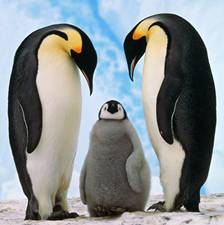
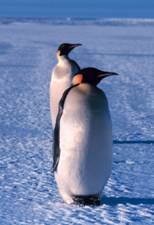
Everyone knows what a penguin looks like. It is instantly recognizable because we have grown up with its image– like images in countless children’s books and cartoons characters, on TV advertisements etc.
Penguins are birds, but they can’t fly. Their wings are too short. Their bodies are too heavy.
The body of a penguin is made for swimming in the ocean and catching food underwater.

Their bodies have a streamlined shape it’s similar to that of aquatic mammals such as seals, dolphins, and whales.
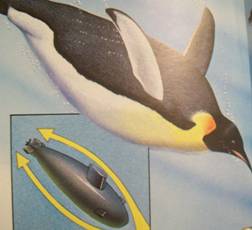
The bodies of penguins are shaped like submarines. This streaming helps them to cut through the water with ease.
Flying bird bone Penguin bone


Flying birds often have hollow bones that are filled with air. This helps to reduce the weight of their bodies and makes it easier for them to get off the ground. But penguins have solid, heavy bones. This helps to increase the weight of their bodies and makes it easier for them to swim and dive.
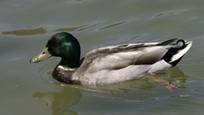
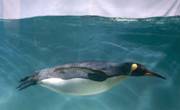
Light birds, like the duck above, float high in the water. They can only use their feet to push them when they swim. Heavier penguins float lower, and can use their powerful wings to push them. This is one reason why penguins can swim much faster.
penguin feathers are very small and tightly packed. There are more than 70 feathers per square inch. The feathers overlap and are coated with oil and this makes them waterproof.



A penguin’s wings work like two paddles. They swing back and forth to drive the penguin through the water. Like paddles, the wings are very stiff. They have large flat bones inside them to keep them from bending. The muscles that move the wings are very strong. They are the largest muscles in a penguin’s body.
The large body of a penguin has plenty of room inside for holding food. Emperor penguins, like the one in below, may eat 30 pounds of food at one time.

They spend most of their lives in the ocean. They have smooth, sleek bodies that are perfect for swimming. Penguins have powerful flippers instead of wings. They use their flippers to move quickly through the water. Penguins can swim faster than most people can run.
Penguins have white bellies and dark backs. They look as though they are wearing little suits! Their coloring protects them from their enemies. When they swim, penguins are hard to see.
Emperor penguins swim very fast in the sea. If you’ve ever watched penguins swoop through the water or dive off icy cliffs, you may have trouble believing that these graceful creatures are actually birds. Their bodies are covered with feathers. They have shiny feathers and layer of fat keep penguins warm. Black feathers grow on the back and the head White feathers cover the belly. The tiny feathers are packed tightly. They overlap at the tips to form waterproof coats. Beneath these outer feathers are soft, fluffy feathers called down that trap air next to the skin. They work to keep the bird warm, just like the feeling of a down jacket. The penguin often cleans and smooths its feathers, or preens. They use its beak to pick up oil from the base of its tail. Then the penguin spreads the oil over its feathers. The oil helps the feathers repel water.
Every year, old feathers fall out. New feathers grow in.

Like humans, penguins are warm – blooded. They make heat inside their bodies. And this means they can stay warm if they can keep most of this heat from leaving their bodies. To keep the heat from escaping, their bodies have several layers of insulation. On the outside, there are tightly packed feathers. Under that, there is a layer of air. Then the skin, and under the skin a thick layer of fat called blubber. The layers of insulation are like the layers of clothing you put on when you want to keep warm
Penguins are so well suited to life in the cold ocean that they have a problem when they come ashore. Sometimes they get too hot! To keep from overheating, penguins pant like dogs to cool off.
They also ruffle their fathers and hold their wings away from their bodies to get rid of extra heat.
Unlike other birds Penguins can not fly. They “fly” under the water instead. Penguins use their small wings to paddle. They use their tails, wings, and feet to steer.
Emperor penguins can stay alive in cold weather more than any other animal on earth. Of all the penguins, the Emperors have the best systems for controlling their body temperatures.
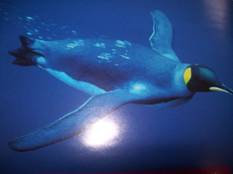
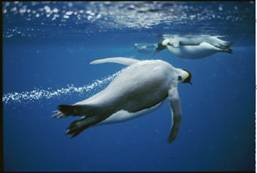
A long, sleek body helps the penguin move quickly underwater.
Many penguins can hold their breath for almost 20 minutes.
Penguin Feet
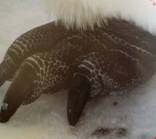
their feet are placed far behind, assume an upright position when they are on land. In each foot has four toes, three of them united by a membrane.
Walking is not something penguins do very well. They waddle from side to side. Sharp claws on the webbed feet grid the ice.
- The webs between the toes of penguins’ feet are an adaptation for quick movement through the water.
 Penguins stand up straight like people because their legs are attached to their bodies at one end. And upright posture is only way they can balance their bodies over their legs.
Penguins stand up straight like people because their legs are attached to their bodies at one end. And upright posture is only way they can balance their bodies over their legs.
 If penguins leaned forward like other birds, they would fall on their faces.
If penguins leaned forward like other birds, they would fall on their faces.
 Penguins have a way of moving fast on land. They just fall on their stomachs and slide like little sleds. To keep moving, they push with their wings and feet, like a skier using poles. This is called tobogganing(tuh-bog–uhn–ing).They can toboggan for many miles.
Penguins have a way of moving fast on land. They just fall on their stomachs and slide like little sleds. To keep moving, they push with their wings and feet, like a skier using poles. This is called tobogganing(tuh-bog–uhn–ing).They can toboggan for many miles.
Sliding is easier than walking.
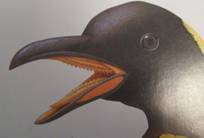 Like other birds, penguins have no teeth, but they do have tough spikes on their mouth. These spikes are ideal for grasping slippery fish.
Like other birds, penguins have no teeth, but they do have tough spikes on their mouth. These spikes are ideal for grasping slippery fish.
The smallest are fairy penguins. They stand about 15” inches (38 centimeters) tall and weigh about 2 pounds(.9 kilograms)

Diving
Nearly a third of diving penguin’s oxygen requirement is carried in its lungs and air sacs, with another third or more in its blood and remainder in its muscles.
It seems that penguins have only a limited capacity for extracting oxygen from myoglobin in their muscles before too many toxins build up. Thus they can only stay underwater for a maximum of 18 minutes, contrasting with an hour in seals. However, because of the efficiency of oxygen transfer through the lungs and air sacs, a penguin can rid itself of toxins (especially carbon dioxide) very quickly and needs only a few seconds at the surface before the next dive.
Little Penguins tend to limit their activities to short, shallow dives. On the other hand King and Emperors regularly dive 330 ft (100m) and have been known to reach depth of 1755 ft (535m).
A bird’s plumage endows it with a waterproof and insulated coat.
“ Penguins are wonderful long – distance swimmers. They often travel in large groups. As they swim, they pop out of the water to gulp air and then plunge back in again. By doing this they can get the air they need without slowing down. This kind of swimming is called “porposing” because porpoises sometimes swim in a similar way.
Penguins are wonderful long – distance swimmers. They often travel in large groups. As they swim, they pop out of the water to gulp air and then plunge back in again. By doing this they can get the air they need without slowing down. This kind of swimming is called “porposing” because porpoises sometimes swim in a similar way.

Like all animals, penguins need water to drink. But when they are at sea, the only water they can get is salt water. For this reason, they have special glands that remove salt from the water they drink. The salt is removed in a liquid form. It flows down grooves in a penguin’s beak and drips off the end.
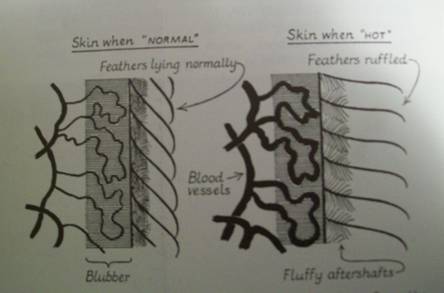
Section of penguin skin to show how heat is lost from the surface by the swelling of blood vessels in the blubber and the opening of the feathers.
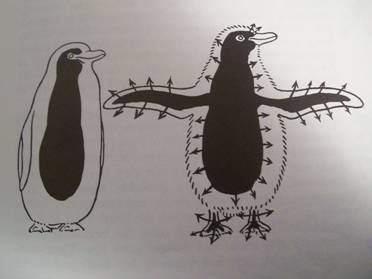
Skin
Penguins have such fine, dense feathers, evenly distributed over their bodies, that the skins have been put to a number of uses in the world of fashion. The Indians of Tierra del Fuego made good use of penguins “whose flesh yielded them food, their Skinners clothing”